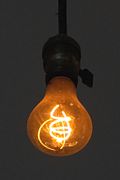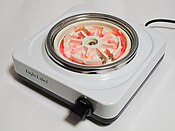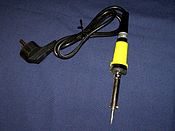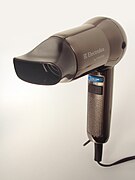Joule effect
The Joule effect is known as the irreversible phenomenon whereby if an electric current circulates in a conductor, part of the kinetic energy of the electrons is transformed into heat due to the constant shocks they suffer with the atoms of the conductive material through which they circulate, raising its temperature. The movement of electrons in a wire is disordered; this causes continuous collisions with atomic nuclei and, as a consequence, a loss of kinetic energy and an increase in temperature in the wire itself.
The name is in honor of its discoverer, the British physicist James Prescott Joule.
History
Resistive heating was first studied by James Prescott Joule in 1841 and, independently, by Heinrich Lenz in 1842.
Joule immersed a piece of wire in a fixed mass of water and measured the temperature rise caused by a known current flowing through the wire over a period of 30 minutes. By varying the current and the length of the wire, he deduced that the heat produced was proportional to the square of the current times the electrical resistance of the wire.
Microscopic Fundamentals
Drude's Pattern
To explain the phenomenon from classical physics, the Drude model can be used.
This model assumes that a conductive material is formed microscopically by a network of immobile positive ions surrounded by free electrons moving through the network that come to form a cloud of electrons. Ions are made up of the atom's nucleus of conductive material and its non-free electrons. This cloud of free electrons prevents the ions from repelling each other, thus allowing them to form the lattice or atomic structure of the material. The electron cloud is in chaotic motion due to the energy provided by the temperature, but it does not produce a net electric current because it is non-directional.
By applying a constant electric field, it exerts a force on the electrons that tends to give direction and meaning to their movement. This constant force produces a constant acceleration on the electron, as predicted by Newton's second law. If the electric field strength were the only one that exists on the electrons, then arbitrarily large currents would originate, since the speed would increase linearly with time.
However, there must be a factor that limits the speed of the electrons and therefore the current. This factor arises naturally when we consider the effect of the interaction of the free electrons and the fixed ion lattice. The electrons collide with an ion and, in this collision, they transfer their energy to the network of ions, reducing their speed.
Collisions between electrons and the lattice are favored by:
- Thermal vibrations: at higher temperature, greater resistance.
- Precise defects: more of them, more resistivity. These defects can be: vacancies (absence of atoms produced at high temperatures), interstitial defects (atoms that are in incorrect positions on the net) or isolated impurities (loaded or neutral).
- Linear defects: dislocations, groups of atoms displaced from their equilibrium position.
- Surface defects, such as external surfaces of solids or internal surfaces (grain limits, etc.).
When current passes through a wire, its temperature increases. The thermal energy thus obtained is produced indirectly by the source of the electric field, through the free electrons and the lattice. From Drude's hypothesis, which supposes that in each collision with the lattice the electron slows down, it is expected that the lattice heats up. This increase in temperature is the Joule effect. The energy transferred from an electron to the lattice by a collision is equal to the kinetic energy lost in the collision.
Calculation of energy and dissipated power
This effect is used to calculate the energy dissipated in a conductor traversed by an electric current as follows:
P=V⋅ ⋅ IE=P⋅ ⋅ t!Δ Δ E=V⋅ ⋅ I⋅ ⋅ t{displaystyle left.{begin{array}{l}P=Vcdot IE=Pcdot tend{array}}right}longrightarrow quad E=Vcdot Icdot t}
The power P dissipated in a conductor is equal to the potential difference V to which it is subjected multiplied by the current intensity I that goes through it. The energy developed E is the product of the power P times the time t elapsed, therefore the energy E is the product of the voltage V by the current I and by the time t.
If we add Ohm's Law to this expression we will have:
E=V⋅ ⋅ I⋅ ⋅ tI=VR!Δ Δ E=V2R⋅ ⋅ t{displaystyle left.{begin{array}{l}E=Vcdot Icdot tI={cfrac {V}{R}}}{end{array}}}}right;longrightarrow quad E={cfrac {V^{2}{R}}{r}}}}{
and also:
E=V⋅ ⋅ I⋅ ⋅ tI=VRΔ Δ V=I⋅ ⋅ R!Δ Δ E=I2⋅ ⋅ R⋅ ⋅ t{displaystyle left.{begin{array}{l}E=Vcdot Icdot tI={cfrac {V}{R}};longrightarrow quad V=Icdot Rend{array}}}}rightlongrightarrow quad E=I^{2}cdot R
The energy developed is equal to the square of the current times the resistance times the time, or what is the same, the square of the voltage times the time divided by the resistance.
Microscopically the Joule effect is calculated through the volume integral of the electric field E→ → {displaystyle {vec {E}} by current density J→ → {displaystyle {vec {J}}}:
P=∫ ∫ ∫ ∫ ∫ ∫ VJ→ → ⋅ ⋅ E→ → dV{displaystyle P=int !int !int !!int _{V}{vec {J}cdot {vec {E}dV,}
Resistance is the component that transforms electrical energy into heat, (for example, an electric stove, an electric stove, an iron, etc.).
Applications
The Joule effect is used in countless devices and industrial processes. The part of the appliance that converts electrical energy into heat using the Joule effect is called the heating element.
| Gallery: Different applications of the Joule effect. | ||||||||||||||||
| ||||||||||||||||
There are many practical uses of the Joule effect:
- An incandescent lamp is illuminated when the filament is heated by Joule effect.
- Electric stoves usually work for Joule effect.
- Electric fuses are based on the fact that if the current flow is exceeded, sufficient heat will be generated to melt the fuse.
- Electronic cigarettes usually work for warming Joule, vaporizing propilenglicol and vegetable glycerin.
- Thermals are resistances whose resistance changes when temperature changes. They are sometimes used in combination with Joule warming: if a large current is sent through the thermistor, the temperature of the device is raised and therefore its resistance changes. If the device has a positive resistance temperature coefficient (PTC), the temperature increase causes a drop in the current, and attributes to the device a circuit protection utility similar to fuses, or for the reaction in the circuits, or for many other purposes. In general, self-heating can become a resistance of a non-linear circuit and hysteresis element.
Contenido relacionado
Diaphragm (optical)
Wheatstone bridge
Einstein field equations














